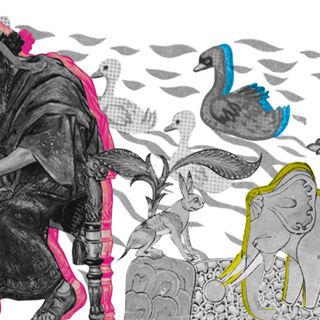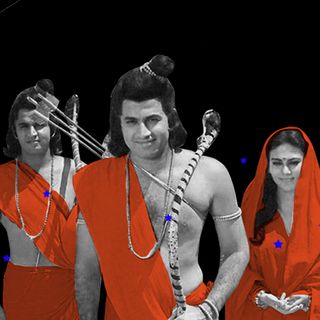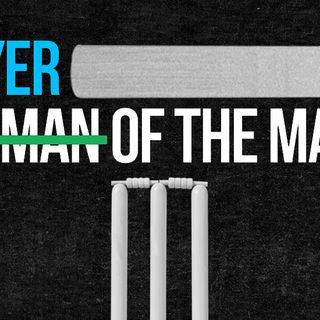
Tell Me More: Talking Caste Dynamics in Bharatanatyam With Nrithya Pillai
“The only purpose of using terms like devadasi is to induce trauma and keep women from courtesan castes away from discourse on the performing arts.”

In The Swaddle’s interview series Tell Me More, we discuss crucial cultural topics with people whose work pushes societal boundaries.
Nrithya Pillai is a Bharatanatyam dancer, dance composer, singer, writer, speaker, and dance instructor who proudly claims her hereditary dance lineage. The Swaddle’s Aditi Murti spoke with Nrithya about the history of Bharatanatyam and hereditary performers, the Madras Devadasis (Prevention of Dedication) Act and its impact on these communities, and the eventual reform and appropriation of Bharatanatyam.
The Swaddle: In a previous interview, you mentioned that you didn’t have an arangetram (debut dance), which was interesting because it’s been a starting point for everyone who learns Bharatanatyam. Was this a conscious decision?
Nrithya Pillai: My male family members were successful teachers of the art form, but they predominantly taught upper-caste women — Brahmin — to be specific. So, while they conducted the arangetrams of other women, they did not believe it necessary for me to have one. I think that is also a repercussion of how the reform and reinvention of the dance form affected women from hereditary castes [like the Isai Vellalar.] The people from hereditary communities who taught the dance were mainly men — women were practically debarred from dancing. The only means to make money via Bharatanatyam was to teach upper-caste women. So, curiously, the feudal relationship between aristocrats and dancers changed to a patron/client-teacher relationship, where the clients were upper-caste women, and the patrons were their families. That change in the equation implied that women from my caste were denied access to the dance form. We had secondary access — our families had the celebrated teachers, and we watched the dance form being taught to upper-caste women. That is how my mother and I learned Bharatanatyam.
Bear in mind, this is not a class problem. My parents are educated and employed. But women from my caste pursuing dance, particularly performance, would have invited character assassinations, because of the history of sexualization. We are groomed to believe that we must find respectability via marriage, education, and family.
TS: When it comes to hereditary performers of Bharatanatyam, there is an assumption that all hereditary women dancers were devadasis. Is this a correct assumption?
NP: The term devadasi carries immense stigma. The Tamil equivalent of the term is thevadiya, which comes from the original term thevar adiyar (meaning servant of god). Thevadiya now means prostitute and is a vicious misogynistic slur word used against women.
The term devadasi was never used in South India before the reform debates. These debates were initiated by a set of newly English-educated cultural nationalists, including people like Muthulakshmi Reddy, whose support for the reform is often cited to legitimise it, as she belonged to the community of hereditary dancers. Such claims require a bit more nuance. Muthulakshmi Reddy, who helped pass the Madras Devadasis (Prevention of Dedication) Act in 1947, was half-Brahmin. She had the means to study and become a doctor. Women from our communities simply did not have that kind of access. They still don’t. Muthulakshmi derived her privilege from her Brahmin father, and therefore, she never identified herself as a woman from the community in any of her biographies. Her mother’s name was Chandrammal, but she never calls her a devadasi in her writings.
The reform debates brought in the usage of the term devadasi into common parlance, with a severe negative connotation — prostitution. So, it’s not surprising that women from hereditary dancing communities feel incredibly uncomfortable with that word. Even today, the term invites controversies. When Vairamuthu called Andal a devadasi, there was an uproar, because Brahmins simply couldn’t accept anyone calling their goddess a devadasi. When T.M Krishna called M.S. Subbulakshmi a devadasi, there was a similar controversy.
Looking at my own family, over the last five to six generations, all my foremothers existed in extremely patriarchal marriages — caste endogamous marriages. To extricate ourselves from the stigma of the term and achieve respectability, my foremothers married within their castes and overcompensated by domesticating themselves. Because the respectability you receive from such a marriage is the only way to save yourself from the term.
Related on The Swaddle:
Yet, the history of dance and the discourse around dance continues to use this term, making it harder for women from our communities to involve ourselves in these conversations. It’s triggering and painful. This stigma is not restricted to women from these communities. Think of veteran politician M. Karunanidhi, who was the Chief Minister of Tamil Nadu for so long. Yet, his caste location (Isai Vellalar) is frequently used sometimes even by those from other oppressed castes to embarrass and humiliate him. The only purpose of using terms like devadasi is to traumatise and keep women from courtesan castes away from the discourse on performing arts. Which is why I prefer using the term hereditary dancing communities.
Depending on their dancing and singing talents, some women within these communities underwent a ceremony called bottukatutal (tying of a sacred thread) — marking them as professional artists. But this doesn’t immediately become marriage to God. This marking as an artist also allowed these women to liaise with powerful men. Is that prostitution? I don’t think so. In fact, I think it was much better than the exclusively caste endogamous and oppressive marriages that women from all communities were subjected to around this time. Women have been oppressed by men for long, but women from courtesan castes enjoyed freedoms that were often not even afforded to upper-caste women. But the latter’s oppressed status receives far less attention than the former.
TS: Another conflation that frequently happens is assuming Devadasi women as primarily from Dalit communities, right?
NP: Several dance forms in South India — primarily Bharatanatyam, Kuchipudi, Mohiniyattam and Vilasininatyam — were appropriated from Bahujan communities, not Dalit communities. Several Dalit communities like yellamma, marthamma, jogini and others, have ritual practices of dedication, but do not have any connection to the performance tradition of Bharathanatyam which is exclusive to the bahujan courtesan hereditary castes like isaivellalar and kalavantula. It’s important to talk about dedications with nuance. While it is still necessary to counter practices of dedications that continue in some communities, one must acknowledge that other communities have long abolished it. Yet, as a repercussion of the reform debates, the usage of the term devadasi clubs together women from different communities and re-traumatizes women from communities where this practice is not prevalent anymore. If reform and reinvention were supposed to be about the democratization of the art, show us women from hereditary and other oppressed communities who are now successful performers?
TS: After the passing of the Prevention of Dedication Act, there was this reinvention of Bharatanatyam — as you mentioned — into a more religious dance without aspects of srungara (erotic love). Why did this happen?
NP: Again, caste. Branding certain bodies as immoral and provocative, and claiming that the dance, when performed by bodies from respectable backgrounds as the ideal. Bharatanatyam’s reinvention could be called a caste-based exclusionary practice. By excluding the bodies of women from lower castes, the dance suddenly becomes pure and all about Bhakti, or devotion. Plus, I choose not to believe in the dichotomy of the ‘older’ Bharatanatyam form versus the reformed version, as it does not acknowledge the generations of hereditary practitioners who have taught both the old and the new. The reformers learnt the art form from traditional practitioners, and simply claimed to remove sensuousness, which they found to be problematic, and added what they thought were asexually appropriate.
There is this important debate that happened in one of the Sangeet Natak Akademi meetings between Rukmini Devi Arundale and Balasaraswati. You see Rukmini Devi speaks in pristine English, while Bala speaks in Tamil. They debate repertoire for long, until Rukmini Devi, the reformist, finally says that it is the body that makes the difference — it is who performs that draws the line between what is vulgar and what is respectable. If you watch a Bharatanatyam performance today, you’ll notice exacting rules and attempts to quantify everything – a very specifically angular aramandi, or the bent knee posture is considered ideal. Abhinaya, or the art of facial expression, is expected to be subtle and not sensuous or erotic. There are knee spins, hyper-focus on ballet-like precision, and an obsession with fair skin and size zero bodies. Without these attributes, you would be rejected as a Bharatanatyam dancer today.
There has also been a recent trend of what I call dress-up devadasi. Some successful Bharatanatyam dancers who claim to be liberal and socially-minded have attempted to dress up as what they claim to be a true representation of a devadasi dancer. They portray an exaggerated, and a highly orientalized nautch girl talking in rustic and colloquial Tamil. This is being done in the guise of increasing awareness of the origins of Bharatanatyam. These women do not even recognize their unconscious bias. They don’t realize the violence of this practice — a bunch of Brahmins who get together and talk about decolonizing Bharatanatyam while dressing up as hereditary dancers even when it is obvious that the first step in decolonizing must be an attempt to repopulate the dance community with dancers from other castes and not role-playing for tokenism. I mention the word devadasi here very purposefully, as it is the term these academics use to grab eyeballs and put forth performative wokeness. They claim to support the marginalized, but they take up space meant for the marginalized. Can you imagine the impact of something like this in other political spaces — would an academician dress up as a Black individual to portray a tableau on Black Lives Matter? Absolutely not! But some Bharatanatyam dancers dress up as M.S. Subbulakshmi, speak as Balasaraswati and have a production about it. There now exists a specific genre called the ‘devadasi dance’ performed almost exclusively by Brahmin academics overseas, to portray what they claim to be a truer representation of a lost form of Bharatanatyam.
This is just full circle appropriation right? When Rukmini Devi created the reformed version of Bharatanatyam, it was appropriated by upper caste women. But now these women say they don’t want the reformed version — they want the older dance. So now they are portraying what they claim is the older form of the dance and appropriating that as well.
Related on The Swaddle:
India Has Often Appropriated, Seldom Appreciated, Its Courtesan Culture
TS: When it comes to modern academic and cultural discourse around courtesan histories, there’s either complete support for courtesan cultures or a complete demonization via centering the sexual violence and abuse of hereditary dancers. What nuance does this discussion need?
NP: I find it fascinating that upper-caste academics frequently highlight sexual abuse and child sexual abuse in other marginalised communities but fail to acknowledge sexual violence within their own communities. They also summarily suggest conjugal monogamy as the only alternative to sexual exploitation of hereditary courtesan women. I am glad people are talking about sexual violence in hereditary dancing communities, but I wish more people would talk about what happened to the great grandmothers of Brahmin women who were practically passed from their father’s lap to their husband’s.
What I am trying to indicate is the condescending bias in only pointing out the violence embedded within one marginalized community, while ignoring equally violent practices within their own. I honestly don’t think it changes the contemporary realities of women from hereditary communities if a Sadanand Menon is going to be overly accepting of traditions of hereditary dance communities, or if a Gitanjali Kolanad is going to be overly critical. I think it is time for people from the community to speak for themselves.
The nuance that is important to be highlighted here is whether relationships between two adults should be policed by the State. It is true that men receive undue power in an institutional relationship and often tend to abuse it due to patriarchal structures. Yet, the scrutiny on patrons and dancers, is basically the policing of relationships, making the entire premise problematic. I do not believe that any kind of caste-based occupation and oppression needs to continue, but that should not take away individual freedoms. Reform denied hereditary dancing women their freedoms. They were simply criminalized and made to stop engaging with dance and music.
TS: Do you see a parallel between conversations on the decriminalization of sex work and advocacy against the Prevention of Dedication Act?
NP: I do follow conversations around decriminalization, like changing the term prostitution to sex work, and acknowledging sex work as labor. I recently performed a piece in which I sang sitting on a bar stool, to draw attention to the plight of bar dancers as they have been criminalized due to government regulations. I see the similarities, but it is also important to highlight the unique plight of contemporary women from hereditary dancing communities.
This interview has been partly translated from Tamil, condensed and edited for clarity.
Aditi Murti is a culture writer at The Swaddle. Previously, she worked as a freelance journalist focused on gender and cities. Find her on social media @aditimurti.
Related


The Buzz Cut: ‘Ramayana’ Is On TV Again, A Year After It Aired During the First Covid19 Lockdown
